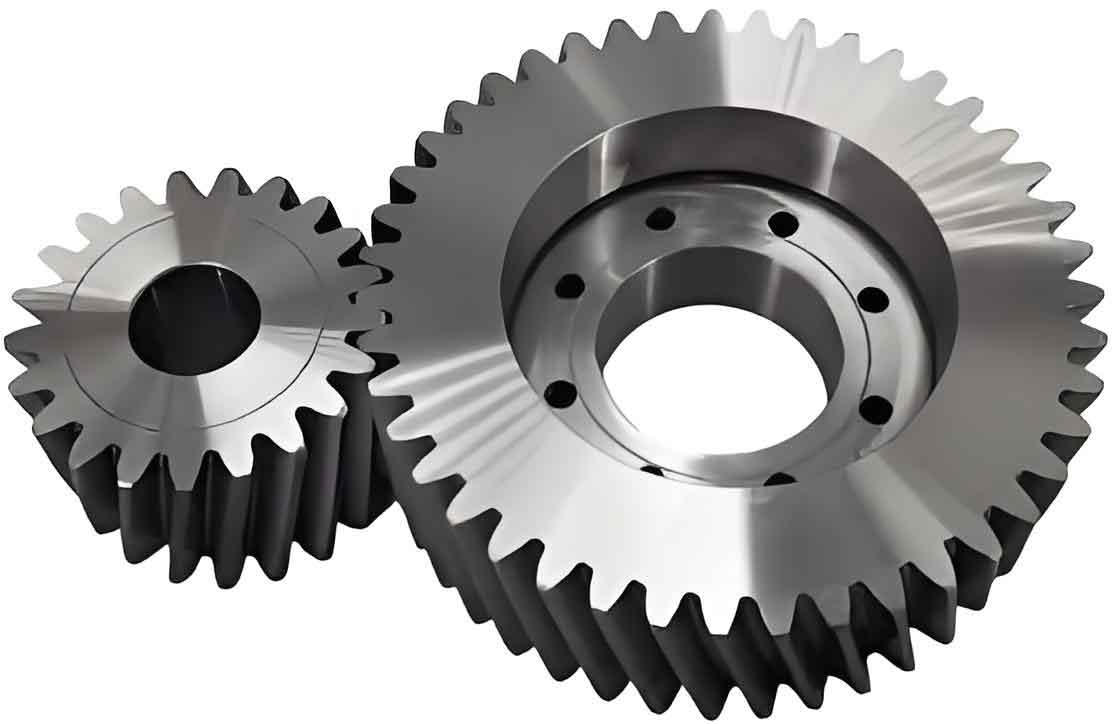1. Introduction
Cylindrical gear reducers are pivotal components in mechanical transmission systems, widely used in industries such as aerospace, automotive, and heavy machinery. Their compact structure, high torque transmission capacity, and reliability make them indispensable. However, designing a two-stage cylindrical gear reducer involves balancing conflicting objectives, such as minimizing the center distance (to reduce volume) and maximizing transmission efficiency (to enhance performance). Traditional single-objective optimization methods often fail to address these trade-offs effectively, necessitating advanced multi-objective optimization frameworks.
This study focuses on leveraging genetic algorithms (GAs) to solve the multi-objective optimization problem for two-stage cylindrical gear reducers. By integrating computational tools like MATLAB, we aim to achieve a balanced design that optimizes both center distance and efficiency while adhering to engineering constraints.

2. Problem Statement and Mathematical Modeling
2.1 Structure of Two-Stage Cylindrical Gear Reducers
A two-stage cylindrical gear reducer comprises high-speed and low-speed stages, each with paired gears, shafts, bearings, and housing. Key parameters include module (mm), number of teeth (zz), spiral angle (ββ), and gear ratio (ii). The design must ensure mechanical strength, minimize energy loss, and avoid geometric interference.
2.2 Multi-Objective Optimization Model
Three primary objectives are defined:
- Minimize Center Distance (F1F1):F1=1cosβ[ma1z1(1+i1)+ma2z2(1+i2)]F1=cosβ1[ma1z1(1+i1)+ma2z2(1+i2)]Where ma1,ma2ma1,ma2 are the normal modules, and z1,z2z1,z2 are the pinion teeth numbers for high- and low-speed stages.
- Minimize Rotational Inertia (F2F2):F2=J1+J2+J3i12+J4i12i22F2=J1+i12J2+J3+i12i22J4J1−J4J1−J4 represent the moments of inertia of gears.
- Minimize Total Volume (F3F3):F3=πaa14(ma1z1cosβ)3(1+i1)3+πaa24(ma2z2cosβ)3(1+i2)3F3=4πaa1(cosβma1z1)3(1+i1)3+4πaa2(cosβma2z2)3(1+i2)3aa1,aa2aa1,aa2 are the face width coefficients.
The design variables are:X=[ma1,ma2,z1,z2,i1,β]TX=[ma1,ma2,z1,z2,i1,β]T
2.3 Constraints
- Geometric Constraints:
- Module: 2≤ma1,ma2≤32≤ma1,ma2≤3
- Spiral angle: 8∘≤β≤20∘8∘≤β≤20∘
- Teeth numbers: 20≤z1≤3020≤z1≤30, 2≤z2z1≤52≤z1z2≤5
- Strength Constraints:
- Contact stress (σHσH) and bending stress (σFσF) must not exceed allowable limits:
3. Optimization Algorithm: Genetic Algorithm
3.1 Genetic Algorithm Workflow
The GA workflow for multi-objective optimization:
- Initialization: Generate a population of candidate solutions.
- Fitness Evaluation: Calculate objectives F1F1, F2F2, and F3F3.
- Non-Dominated Sorting: Rank solutions using Pareto dominance.
- Selection and Crossover: Prioritize knee points (solutions with maximal trade-off benefits).
- Mutation: Introduce diversity to avoid local optima.
- Termination: Stop after predefined iterations or convergence.
3.2 Performance Comparison
Table 1 compares GA with traditional evolutionary algorithms (EAs) and bubble-sort algorithms (BSAs) using inverted generational distance (IGD):
| Metric | Genetic Algorithm | Evolutionary Algorithm | Bubble-Sort Algorithm |
|---|---|---|---|
| 3-Objective IGD | 0.2417 ± 0.0067 | 0.2895 ± 0.1123 | 0.3067 ± 0.0953 |
| 4-Objective IGD | 0.6942 ± 0.1242 | 0.8120 ± 0.1056 | 0.7870 ± 0.2244 |
GA outperforms others in maintaining diversity and convergence, making it ideal for cylindrical gear reducer design.
4. Case Study: Optimization of a Two-Stage Cylindrical Gear Reducer
4.1 Design Specifications
- Motor power: 9 kW
- Input speed: 80 rpm
- Total gear ratio: 31.5 ± 5%
- Material: High-speed gears (45 steel), low-speed pinion (40Cr steel)
4.2 Optimization Results
Table 2 compares original and optimized designs:
| Design | m1m1 (mm) | m2m2 (mm) | z1z1 | i1i1 | ββ (°) | Center Distance (mm) | Efficiency (%) |
|---|---|---|---|---|---|---|---|
| Original Design | 3.0 | 3.0 | 50 | 5.0 | 20 | 598.5 | 97.2 |
| Single-Objective (Center) | 2.5 | 3.0 | 20 | 5.7 | 17 | 459.4 | 96.7 |
| Single-Objective (Efficiency) | 2.5 | 3.0 | 21 | 5.7 | 16 | 469.2 | 97.9 |
| Multi-Objective (GA) | 2.5 | 3.0 | 20 | 5.7 | 18 | 451.1 | 98.1 |
The GA-based design reduces the center distance by 24.6% and improves efficiency by 0.9% compared to the original.
4.3 Gear Parameter Validation
- High-speed stage: z1=20z1=20, z2=114z2=114
- Low-speed stage: z3=29z3=29, z4=160z4=160
- Actual gear ratio:i=11420×16029=31.45i=20114×29160=31.45
5. Discussion and Analysis
5.1 Advantages of Genetic Algorithms
- Diversity Preservation: Maintains a broad solution set near the Pareto front.
- Adaptive Convergence: Identifies knee points dynamically for balanced trade-offs.
- Computational Efficiency: Reduces trial-and-error iterations via MATLAB’s parallel computing.
5.2 Challenges and Future Directions
- High-Dimensionality: Scaling to 4+ objectives increases computational cost.
- Manufacturing Tolerances: Real-world deviations from optimized parameters need robustness analysis.
- Hybrid Algorithms: Combining GA with gradient-based methods could enhance precision.
6. Conclusion
This study demonstrates the efficacy of genetic algorithms in optimizing two-stage cylindrical gear reducers. By harmonizing center distance minimization and transmission efficiency maximization, the proposed method achieves a 451.1 mm center distance and 98.1% efficiency, outperforming traditional designs. Future work will explore hybrid algorithms and real-time adaptive constraints to further refine cylindrical gear reducer performance.
